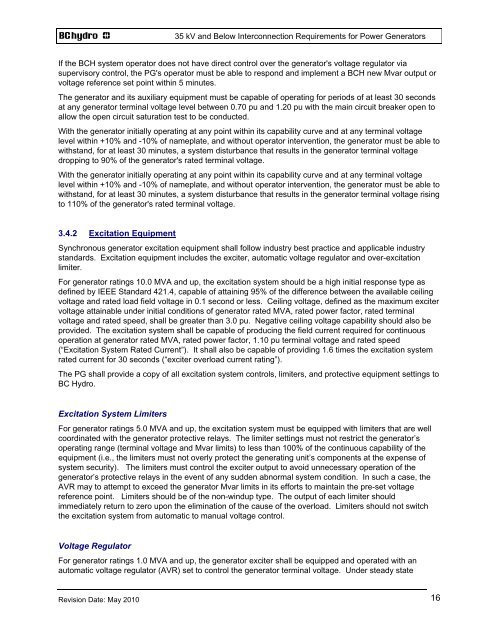35 kV and Below INTERCONNECTION REQUIREMENTS - BC Hydro
35 kV and Below INTERCONNECTION REQUIREMENTS - BC Hydro
35 kV and Below INTERCONNECTION REQUIREMENTS - BC Hydro
Create successful ePaper yourself
Turn your PDF publications into a flip-book with our unique Google optimized e-Paper software.
Revision Date: May 2010<br />
<strong>35</strong> <strong>kV</strong> <strong>and</strong> <strong>Below</strong> Interconnection Requirements for Power Generators<br />
If the <strong>BC</strong>H system operator does not have direct control over the generator's voltage regulator via<br />
supervisory control, the PG's operator must be able to respond <strong>and</strong> implement a <strong>BC</strong>H new Mvar output or<br />
voltage reference set point within 5 minutes.<br />
The generator <strong>and</strong> its auxiliary equipment must be capable of operating for periods of at least 30 seconds<br />
at any generator terminal voltage level between 0.70 pu <strong>and</strong> 1.20 pu with the main circuit breaker open to<br />
allow the open circuit saturation test to be conducted.<br />
With the generator initially operating at any point within its capability curve <strong>and</strong> at any terminal voltage<br />
level within +10% <strong>and</strong> -10% of nameplate, <strong>and</strong> without operator intervention, the generator must be able to<br />
withst<strong>and</strong>, for at least 30 minutes, a system disturbance that results in the generator terminal voltage<br />
dropping to 90% of the generator's rated terminal voltage.<br />
With the generator initially operating at any point within its capability curve <strong>and</strong> at any terminal voltage<br />
level within +10% <strong>and</strong> -10% of nameplate, <strong>and</strong> without operator intervention, the generator must be able to<br />
withst<strong>and</strong>, for at least 30 minutes, a system disturbance that results in the generator terminal voltage rising<br />
to 110% of the generator's rated terminal voltage.<br />
3.4.2 Excitation Equipment<br />
Synchronous generator excitation equipment shall follow industry best practice <strong>and</strong> applicable industry<br />
st<strong>and</strong>ards. Excitation equipment includes the exciter, automatic voltage regulator <strong>and</strong> over-excitation<br />
limiter.<br />
For generator ratings 10.0 MVA <strong>and</strong> up, the excitation system should be a high initial response type as<br />
defined by IEEE St<strong>and</strong>ard 421.4, capable of attaining 95% of the difference between the available ceiling<br />
voltage <strong>and</strong> rated load field voltage in 0.1 second or less. Ceiling voltage, defined as the maximum exciter<br />
voltage attainable under initial conditions of generator rated MVA, rated power factor, rated terminal<br />
voltage <strong>and</strong> rated speed, shall be greater than 3.0 pu. Negative ceiling voltage capability should also be<br />
provided. The excitation system shall be capable of producing the field current required for continuous<br />
operation at generator rated MVA, rated power factor, 1.10 pu terminal voltage <strong>and</strong> rated speed<br />
(“Excitation System Rated Current”). It shall also be capable of providing 1.6 times the excitation system<br />
rated current for 30 seconds (“exciter overload current rating”).<br />
The PG shall provide a copy of all excitation system controls, limiters, <strong>and</strong> protective equipment settings to<br />
<strong>BC</strong> <strong>Hydro</strong>.<br />
Excitation System Limiters<br />
For generator ratings 5.0 MVA <strong>and</strong> up, the excitation system must be equipped with limiters that are well<br />
coordinated with the generator protective relays. The limiter settings must not restrict the generator’s<br />
operating range (terminal voltage <strong>and</strong> Mvar limits) to less than 100% of the continuous capability of the<br />
equipment (i.e., the limiters must not overly protect the generating unit’s components at the expense of<br />
system security). The limiters must control the exciter output to avoid unnecessary operation of the<br />
generator’s protective relays in the event of any sudden abnormal system condition. In such a case, the<br />
AVR may to attempt to exceed the generator Mvar limits in its efforts to maintain the pre-set voltage<br />
reference point. Limiters should be of the non-windup type. The output of each limiter should<br />
immediately return to zero upon the elimination of the cause of the overload. Limiters should not switch<br />
the excitation system from automatic to manual voltage control.<br />
Voltage Regulator<br />
For generator ratings 1.0 MVA <strong>and</strong> up, the generator exciter shall be equipped <strong>and</strong> operated with an<br />
automatic voltage regulator (AVR) set to control the generator terminal voltage. Under steady state<br />
16
















